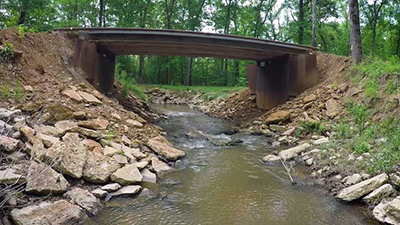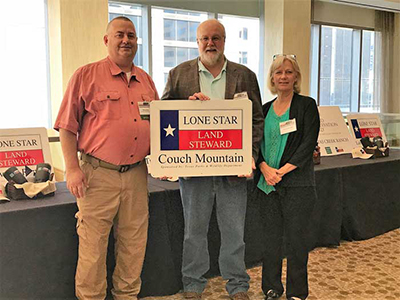
Nelson Roach calls it his little bit of Shangri-La, a six-mile stretch of northeast Texas creek that eventually finds its way to a lake where behemoth catfish prowl. And for good reason: Roach, a lawyer by profession and a conservationist by practice, has transformed part of Prairie Creek into a habitat where river otter, white-tailed deer and other wildlife thrive. He’s restored a stream that “didn’t look right” into something that is a treasure to behold.
The creek winds through Couch Mountain Ranch, which Roach owns. When he bought the property containing the creek, “it was stagnant and barely flowed,” said Roach, a 59-year-old commercial litigation attorney.
Three years ago, he began working with Texas conservationists and the U.S. Fish and Wildlife Service (Service) to make the creek pretty again – make it a better environment for wildlife, too. At the same time, he made sure to preserve a tract that is cut for timber. Roach understands that he can embrace conservation and business.
Prairie Creek is one of several streams that leads into Big Cypress Creek. That flows into Lake O’ the Pines, a 19,000-acre reservoir that provides drinking water for more than 100,000 area residents. Several Big Cypress tributaries contained bacteria levels dangerous to recreation, let alone drinking. Roach, wanting to improve Prairie Creek’s water quality, agreed to remove several culverts and water crossings on the stream.
The results have been dramatic. That project not only improved the water but improved the habitat for creatures that live in the water, including two state-listed endangered freshwater mussels.
Last year, he participated in a “forest-to-faucet” initiative, inviting municipal water officials to tour the creek as it winds through his 8,200-acre ranch. The lesson: water quality begins long before water makes it to treatment plants.
“The health of your water,” he said, “starts where that first drop hits the ground.”
Roach’s efforts to improve water quality are but a drop in the bucket when it comes to what he has done for the land. Roach has promoted forest health with prescribed burn operations, clearing underbrush that allows trees and wildlife to flourish. The burns have stabilized soil composition and reduced runoff into the creek, too.
His love of plain and forest, said Roach, came about relatively recently. He calls it an “awakening.”
“My perspective completely opened up,” said Roach, in a warm twang reminiscent of his Louisiana upbringing. “I wanted a little piece of land for myself here — and my eyes have been opened to what the land wants from me.”
Growing up, Roach spent plenty of time hunting and fishing with his brothers and dad. After attending Baylor University, Roach for a year drove an 18-wheel rig hauling electrical wireline equipment for offshore oil operations between his home state and the Texas Gulf Coast.

“It was an interesting experience,” he said. More important, it earned him enough to get into law school. “I loved what I was learning and was eager to put it into practice,” he said. “I wanted to get ahead.”
After clerking for the Texas Supreme Court and working in Austin a few years, Roach moved to east Texas to work for a law firm in Daingerfield. It stirred something in his country-boy heart.
“I love the country up here,” said Roach. “To be honest, I never did get into golf, like many of my cohorts in the state capital.”
In 2000, a senior partner at the firm decided to sell his 16,000-acre ranch to a real estate trust. Eventually, Roach bought a 1,600-acre parcel, “my own little piece of paradise.”
That little piece started growing as the land trust began selling off more sections of the original ranch. Over six years, Roach acquired 8,200 acres — just more than half of the original property, including the portion managed for timber.
“This was my Shangri-La,” recalled Roach. “I was totally ignorant to how environmentally sensitive the land was.”
He proved to be a quick study, said Laura Speight, a retired biologist with the Texas Parks and Wildlife Department. She met Roach in 2007, when he invited her to check out his property and advise him in managing white-tailed deer.
“Nelson started with an interest in improving the deer on his property,” said Speight. “But it wasn’t long before he became totally focused on the bigger picture, on how what’s good for deer, like healthy forests, is good for fish and birds.”
His interest piqued, Roach began researching environmentalism. When he came across the work of Aldo Leopold, author of the 1949 classic “Sand County Almanac,” his conversion was complete. He was a conservationist.
And the deer, the reason Roach and Speight got together?
Roach still hunts — but no longer for sport; now, it’s strictly a matter of keeping the deer population in check. His deer blinds, Roach has discovered, are perfect places to watch the hawks, squirrel, great egrets, blue herons, the occasional bobcat, coyote, mink and countless red-headed woodpeckers that have made his land their home.
“I saw five woodpeckers on the same tree the other day!” he exclaimed.
Roach also met Steve Arey, a Service biologist who oversees the agency’s Partners for Fish and Wildlife program in Texas. With Arey’s help, Roach restored Prairie Creek to its historic depths and natural flow, and improved its water clarity and quality — all important for native freshwater mussels to survive.
Roach then let the Service conduct surveys to fill a “large gap” in what is known about the mussels, Arey said. Roach’s efforts did not stop there. He and other adjacent property owners created a wildlife management cooperative to help state officials restore eastern turkey populations. This spring, the co-op lands became the release site of 80 wild turkeys.
Speight has great hope for the birds. “It’s a great spot for them,” she said.
Roach’s efforts have had a ripple effect for wildlife across his property. The conservation work on his land has created direct and indirect benefits for approximately 216 bird, 47 mammals, 90 reptile and amphibian species, 86 fish, and 33 freshwater mussel species found within the Big Cypress basin, Arey said.
The work also has had an effect on Roach. These days, he feels the tug of land stewardship as much as he does the practice of law. He is thinking beyond his retirement, and has decided to include in his will the stipulation that his land be managed under a private foundation for research and education. It will become a living laboratory for ecological conservation practices.
Roach is sharing his land’s bounty, too. He recently started hosting Boy Scout outings and field trips for underprivileged kids on his ranch. Conservation, he said, is “for naught if our future generations are uninterested and unengaged.”
“My hope is that somehow this can be a teachable moment, even for people like myself who had been interested in buying land primarily for recreational purposes,” he said. “When you see there’s more to it all than just sport, it opens a whole new dimension and encourages a deeper understanding of the land and its needs.”
 Sign In
Sign In
 Sign In
Sign In
